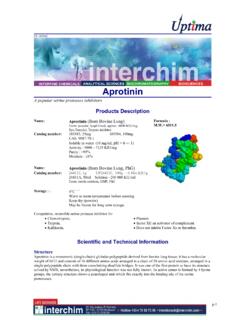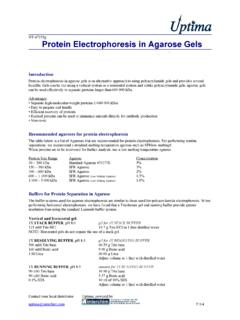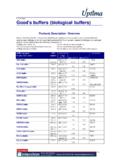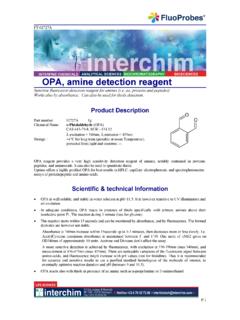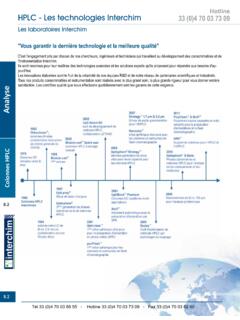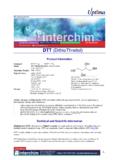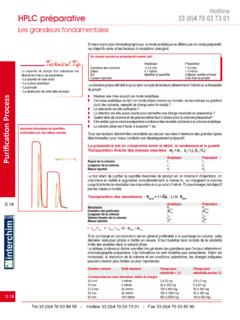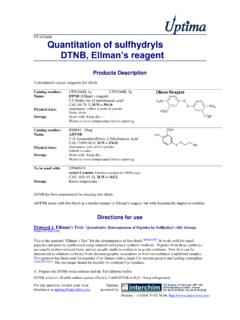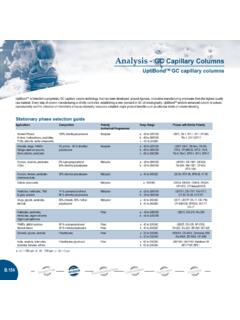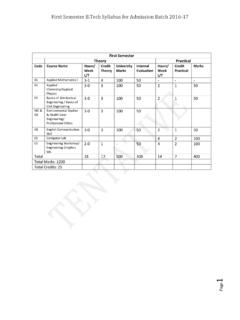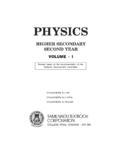Transcription of DiI, DiD, DiR, DiO, DiA - interchim.fr
1 FT-46804 ADiI, DiD, DiO, DiR, DiA, DiBLipophilic carbocyanine fluorescent dyes for membrane labeling Product InformationProduct (g mol-1)CAS # exc\ em. max.(nm)Mol. abs.(M-1cm-1)SolubleinDiOC18(3) [DiO](L) FP-46805A, 50 / 501 154 000 DMFDMSODiOC6(3)(L) FP-46764A, 100 / 501154 000 DMSODiOC14(3)(L) FP-AM329A, 50 / 515 MetOh / EtOHDMSOSP-DiOC18(3)(L) FP-40265A, 10 / 514175 000 MetOh / EtOHDMSO5,5 -Ph2-DiOC18(3)(L) FP-M1610A, 10 / 512 MetOh, DMFDMSODilC1(3)(L) FP-46853A, 100 / 540 DMSOCHCl3, DMFDiIC1(5)(L) FP-20920A, 100 658 DMSO, DMFEtOHDilC1(7) (L) FP-C86280, 100 / 766 DMSOEtOH, CHCl3 DilC5(3) (L) FP-BT5040, 100 / 576 DMSOEtOH, DMFDilC12(3)(L) FP-46736A, 100 / 566144 000 DMSO, DMFEtOH, CHCl3 DilC16(3) (L) FP-46746A, 100 / 566148 (g mol-1)CAS # exc\ em. max.(nm)Mol. abs.(M-1cm-1)SolubleinDilC18(3) [Dil] (*)(L) FP-46804A, 50 / 566148 000 DMSOEtOH, CH3 CNDiIC18(3) [Dil], crystalline(L) FP-162451, 25 / 566148 000 DMSO, DMFEtOH, CHCl3 Dilinoleyl Dil Solid(L) FP-12792A, 5 / 564134 600 DMSON euro-Dil(L) FP-AM330A 25 / 565145 000(MetOH)DMSO / DMFMetOH / EtOH 9-Dil(L) FP-M1280A, 25 / 565 DMSO, CH3 CNEtOH, DMF6,6'-Ph2-DilC18(3)(L) FP-M1613A, 5 / 572 DMSO, CHCl3 EtOH, DMFDilC18(5) [DiD] 4-chlorobenzenesulfonate salt(M) FP-22574A, 50 / 663193 000 DMSOEtOH, DMFDilC18(5) oil [DiD] perchlorate FP-929099, 10 mgFP-92909A, 25 / 665270 000 CHCl3, DMSOMeOH, acetoneDilC18(5) oil [DiD] iodideFP-DY3330, 25 / 665270 000 DMSODilC18(7) [DiR](M) FP-69084A, 25 / 780(MetOH)270 000 DMSOEtOHNeuro-DiO (**)(M) FP-AM331A, 25 / 501270 000 DMSO /EtOHHexane, oilNeuro-DiO (**)(M) FP-BA641A, 0,2 / 501270 000 DMSO /EtOHHexane, oilDiA(L)
2 FP-66096A, 25 mgsee FT-46720A (Styryl dyes) / 61352 000(MetOH)DMSO and EtOHDiB(L) FP-YS2860, 10 mg1074353 / 442 DMSO, DMF or EtOH(*) DilC18(3) solution is also available for microinjections: FP-AM328A ( ml)(**)Neuro-DiO also is available in solution for microinjections: FP-BA641A ( ml) :DiOC18(3), DiOC14(3), Dil, Neuro-Dil, Dilinoleyl DiI solid, DiA, DiB can be stored at +4 C (L) DiD, DiR and Neuro-DiO should be stored at 20 C (M). Keep in a closed container and protect from solution in DMSO can be stored 3-6 months at -20 degres dyes have hydrophilic/hydrophobic pattern, withstrongest fluorescence when they are in are used in living and fixed tissues and cells. These dyes insert intothe membrane, and diffuse rapidly, staining the entire cell the synaptic terminals tracing in a single motor and DiO are also efficient postmortem neuronal tracers and used inneuroanatomy and visual science (Lukas 1998)They can be combined together according to the spectre below, showingnormalized fluorescence spectra in (3) and DiOC(3) are respectively compatible with rhodamine (TRITC) filter and fluorescein (FITC) (3) is a fluorescent probe for measuring membrane (3) [DiO] (3,3 -dioctadecyloxacarbocyanine, perchlorate) is a widely used fluorescent membrane dye.
3 However, DiO has been fluorescent emission and the lateral diffusion rate on the membranes is generally slower than that of DiI. DiO and DiI are often used together in dual color studies. Please also see our Neuro-DiO, which has improved property over (3) (3,3 -ditetra decyloxacarbocyanine, hydroxyethanesulfonate) is a derivative of DiOC18(3) [DiO] but is more soluble in aqueous buffer. Staining is accomplished by simple incubation of cells in the buffer containing the (3) is a lipophilic sulfonated carbocyanine tracer (3) [Dil] (1,1 -dioctadecyl-3,3,3 ,3 -tetramethylindocarbocyanine perchlorate) is a widely used carbocyanine membrane dye that labels cell membranes by inserting its two long (C18 carbon) hydrocarbon chains into the lipid bilayers. It is the most standard lipophilic dye for ER, Golgi , it has been extensively used for the anterograde and retrograde labeling of neurons.
4 The intense fluorescence and high photostability of the dye make it possible to visualize the fine structures (axons and dendrites) of the neurons. Also, because of its low toxicity and the tendency to give highly stable cell labeling , the dye has been generally used for long term cell tracing of cells both in cultures and in living embryos or animals. The dye is usually applied to cells either from an ethanol solution (for cells in cultures) or directly from the dye crystals (for neurons in tissues, for example). DiI emits its fluorescence in the orange red region and it can be used with standard fluoresceinand rhodamine optical filter, and combined to the green fluorescent dye DiO (FP-46805) for dual color (3) is a cell-permeant, green-fluorescent, lipophilic dye that is selective for the mitochondria of live cells, when used at low concentrations. At higher concentrations, the dye may be used to stain other internal membranes, such as the endoplasmic and Neuro-DiO are derivatives respectively of Dil and DiO.
5 They have better solubility and do not form aggregates, which tend to quench the fluorescence. Also, they diffuse faster than Dil and DiO on cell membranes and also may result in a more stable (3), DiIC5(3) and DilC1(7) are potential-sensitive (5) [DiD] (1,1'--dioctadecyl-3,3,3',3'- tetramethylindodicarbocyanine, 4-chlorobenzenesulfonate salt) issimilar to DiIC18(3), but excitable with longer wavelength than carbocyanines (He-Ne laser). It is usefull whensignificant intrinsic fluorescence is observed with DiI or DiODiIC18(7) [DiR] (1,1 -dioctadecyltetramethyl indotricarbocyanine Iodide) is lipophilic carbocyanine similar to DiI and DiO with near IR absorption and emission, allowing lowering the level of autofluorescence. It can be used in multicolor detection, combined to DiD (FP-22574A), DiI (FP-46804A) and Neuro-DiO (FP-AM330A).6,6'-Ph2-DilC18(3) is a cationic membrane (4-(4-dihexadecylaminostyryl)-N-methylpy ridinium iodide), a fluorescent carbocyanine dye, insert in membrane and commonly used for neuronal membrane tracing by diffusion (it diffuses faster than DiO).
6 It is used in aldehyde-fixed tissue. It has very broad emission spectrum and can be detected with green, orange or even red filters. It is combined notably DilC18(3) for 2 colors for useHandling and Storage Dialkylcarbocyanine dye is dissolved in DMF or ethanol at 1 mM or approximately 1mg/mL to make a stock solution. These dyes are generally thermally stable. To facilitate the dissolution, the dyes can be put in a warm is a good idea to filter the highly clark colored solution through a or m membrane filter to ensure a clear solution. The solution thus prepared should be stored at room temperature and protect from light. To avoid dye re-precipitation, do not store the stock solution at below room temperature. The stock solutions must be examined for crystal formation. If crystals are noted, the solution should be warmed (at 37 C or a higher temperature) or sonicated to redissolve the dyes are available in solution.
7 It is used for microinjections in the place of crystalline made solution in DMF is sonicated, centrifugated or filtrated to remove undissolved dye for use on cells suspensionThis procedure may serve as a reference for the use of following products : DiI, DiD, DiOC14(3), DiR, Neuro-DiI and Neuro-DiO. Optimization procedure may be necessary for each specific dye and cell optimal staining, prepare cells at a density of ~ 1 x 106/mL in a serum- free culture medium. If possible, use a single cell suspension for uniform cell staining. Divalent cations such as Ca2+ and Mg2+ may promote dye , for best result, we recommend the use of Dulbecco' s PBS (Ca2+ and Mg2+ free) for the staining. Serum proteins and lipids should be removed from the medium because they may bind the dyes and reduce the effective dye the dye stock solution to the cell suspension to achieve a final dye concentration of ~5 M, or approximately 5 g/uL, corresponding to a 200x dilution.
8 Mix well by gentle at +37 C. Incubation time may vary from a few minutes to 20 min, depending on the cell the stained cells from the staining solution by centrifugation at +37 C at 1500 rpm for a few the supernatant and resuspend the cells in fresh medium at +37 the cells at least two more times according to steps 3 and the stained cells equilibrate for 10-15 min prior to fluorescence may be fixed with 2% paraformaldehyde and should be stable for up to 3 for use on fixed tissue (Pavlidis, 2003)1-Tissue is fixed in 4% paraformaldehyde in phosphate buffer, at room of the dye can be at +4 C or room : higher temperature could be increase transcellular reagents, detergents and high concentration of organic solvents may cause the degradation of stained with dye can be sectioned by cryostat or vibratome methods. But be careful to the possible bad resolution of Dil products FP Membrane Markers (FPMM 1-43, 4-64, 2-10, 1-44, 1-84, 5-95; SynaptracerTM)ReferencesDil, DiO-Lukas JR, et al.
9 , Carbocyanine Postmortem Neuronal Tracing: Influence of Different Parameters on Tracing Distance and Combination with Immunocytochemistry , J. Histochem. Cytochem., 46, 901 (1998) Article-Mu oz-Barroso , et al., Dilation of the Human Immunodeficiency Virus-1 Envelope Glycoprotein Fusion Pore Revealed by the Inhibitory Action of a Synthetic Peptide from gp41 , J. Cell Biol., 140, 315 (1998) Article -Soroceanu L, et al., Modulation of Glioma Cell Migration and Invasion Using Cl and K+ Ion Channel Blockers , J. Neurosci., 19, 5942(1999) ArticleDilinoleyl DiI Solid Chen et al., Exercise Reduces GABA Synaptic Input onto Nucleus Tractus Solitarii Baroreceptor Second-Order Neurons via NK1 Receptor Internalization in Spontaneously Hypertensive Rats, J. Neurosci., 29: 2754 - 2761 (2009) Article Savignat M. et al., Rat Nerve Regeneration with the Use of a Polymeric Membrane Loaded with NGF, Journal of Dental Research, 86: 1051 - 1056 (2007) ArticleDiOC1(3)-Jacobberger JW et al.
10 Flow cytometric analysis of blood cells stained with the cyanine dye DiOC1[3]: reticulocyte quantification, Cytometry, 5(6):589-600 (1984) Abstract-Kelly et al.: Photog. 18,68 (1974)DiOC6(3)- Doria M. et al., Protective function of autophagy during VLCFA-induced cytotoxicity in a neurodegenerative cell model, Free Radical Biology and Medicine, 137:46-58 (2019) Abstract- Saumet A. et al.: Type 3-repeat/C-terminal domain of thrombospondin-1 triggers caspase-independent cell death through CD47/3 in promyelocytic leukemia NB4 cells, Blood 10:1182 (2005)".. was assessed using the 3,3'dihexyloxacarbocyanine iodide (DiOC 6 (3)) lipophilic cationic fluorochrome (20 nM, Interchim, Montlucon, France).. "SP-DiOC18(3) -Demuth DR, et al. Interaction of Actinobacillus actinomycetemcomitans outer membrane vesicles with HL60 cells doesnot require leukotoxin." Cell Microbiol 5, 111-21 (2003)-Zhang M, Kalinec F.
